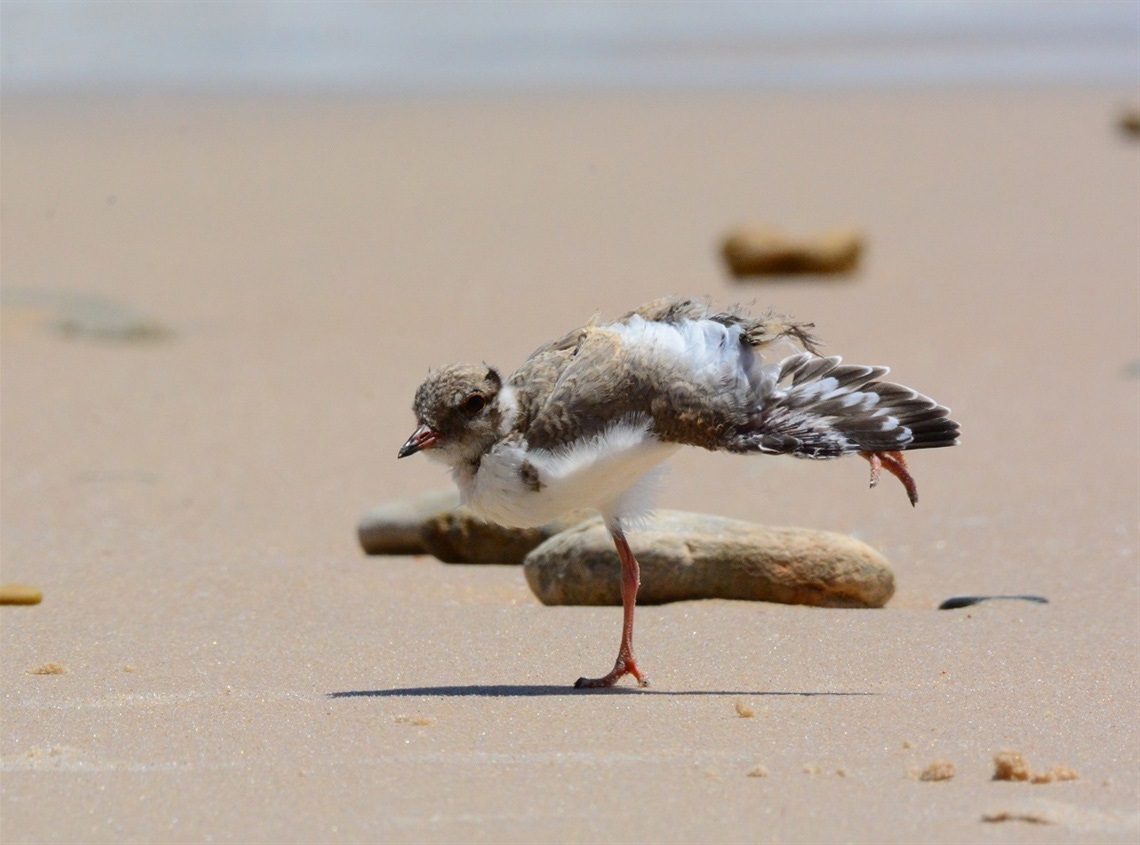
Published on 13 February 2023
Hooray for Hoodie chicks
There’s exciting news in the hood! The first two Hooded Plover fledglings from Onkaparinga for the season have taken flight at Port Willunga.
Once chicks have fledged (learnt to fly), their chances of survival and escaping from predators are much improved, helping to ensure a sustainable population for the threatened shorebirds.
Mum and dad had a lot of support from BirdLife Australia volunteers, who can now focus on the other Onkaparinga breeding sites that are still going.
Volunteers visit breeding sites daily to monitor the birds, replace signs and temporary fencing to help the community understand where the breeding zones are and how to help protect the birds. The program is coordinated by BirdLife Australia with support from Green Adelaide, Hills and Fleurieu Landscape Board and the City of Onkaparinga. The volunteers thanked the community for their great support to give the birds a bit of safe space to raise their young.
This pair had five nesting attempts this season, with the first four nests washed away by high tides with all the early-season storms. Unfortunately, the location they chose on the northern part of Port Willunga Beach, in a section known as Chinaman Gully, was very susceptible to being washed over by high tides.
Threats to the Hoodies
Storms are not the only threats. Each “Hoodie” nest faces different challenges. Threats can include disturbance from human activities on busy beaches, including being frightened by dogs. They’re also at risk from predators including foxes, magpies, seagulls, ravens and birds of prey, who have been known to eat Hoodie eggs or tiny chicks.
To find out more about Hooded Plovers and the threats they face, watch BirdLife Australia’s short animation, Plight of the Hoodie: a little Aussie battler.
Season at a glance
From the eight Hooded Plover pairs on council beaches, there are currently three nests with chicks. The others are either incubating their eggs or have recently had failed nests but may try again before season’s end. The families with chicks include our famous Harvey and his new partner, who is unbanded. Daphne was never to be seen again. There is also an extra pair at Port Stanvac, outside of the City of Onkaparinga’s jurisdiction.
A Maslin Beach chick that hatched on Christmas Day was close to fledging when it disappeared a few weeks ago, and volunteers aren’t sure what happened to it. The community was very supportive, and upset to hear of its disappearance.
Helping our Hoodies
Amazingly, one of the Port Willunga fledglings had been taken to a vet weeks earlier by a well-meaning beach visitor, who thought it was injured.
BirdLIfe Australia’s, Kerri Bartley discouraged the community from approaching Hooded Plovers at the beach.
“Well-meaning people sometimes think a chick has been abandoned because the young bird’s instinctive behaviour is to freeze and crouch down when threatened,” Kerri said.
“They do this so they can use their camouflage to hide, while the parents will use distracting techniques such as a ‘broken wing display’ to try to lure predators away.
“Thankfully the chick was returned to its parents as soon as possible, and the parents accepted it back straight away, with its development delayed by about three days.
“We think this may have been the same chick that had earlier been found stuck in a hole that some kids had dug. It was helped out of the hole by passers-by and the hole was filled in to prevent it from becoming trapped again. It certainly has faced a few challenges!”
For more information on how to do your bit during the Hooded Plover breeding season (August to March), check out our story at the beginning of the season.
An Aldinga adventure
In other eventful Hoodie news, a three-day old single chick that hatched on Aldinga Beach, made an epic four-hour journey north with its parents last week!
The three birds trekked more than a kilometre to a section of beach that usually attracts less beachgoers, in what’s likely to be a safer spot for the family to raise the chick.
BirdLife's Kerri Bartley said it was a reminder Hooded Plover chicks are highly mobile, and volunteers and council can’t always keep the signs in the exact locations where they're feeding.
"The volunteers do their best in trying to move the signs with the birds but sometimes the birds move outside of the signed areas to escape predators and to forage," Kerri said. "The birds don’t seem to be able to read the signs just yet!"
The journey was supervised from a safe distance by a group of dedicated BirdLife volunteers to alert beach users along the way.
If you are interested in signing up to become a volunteer to help protect our beloved threatened Hooded Plovers please visit the BirdLife website to register.
Pictured
One of the Port Willunga chicks (at 37 days old) stretches in preparation for flight (photo: Sue and Ash Read). Please note: this photo was taken by experienced volunteers using large telephoto lenses from a distance.